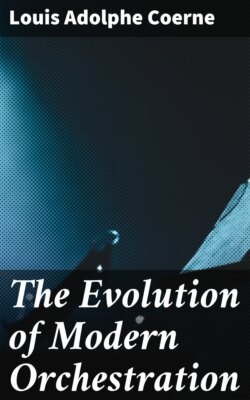Читать книгу The Evolution of Modern Orchestration - Louis Adolphe Coerne - Страница 31
Chapter IV. Beginnings of Orchestration.
ОглавлениеMonteverde's creative genius led to three tangible results:—(1) Dramatic expression; (2) the founding of a serviceable orchestra based on bowed instruments; (3) diversity of style between vocal and instrumental composition.
(1) In writing for the stage, he aimed at an intensification of dramatic effects, variety in tone-color, a freer accompaniment, and relief from the monotony of recitative by the employment of a primitive arioso form. The fruits of these dramatic efforts were reaped by Carissimi in Italy, Schütz in Germany, Lulli in France.
(2) The founding of a serviceable orchestra was the result of his expressive and dramatic instinct fostered by the attempts of the Florentine experimentalists,—orchestral music and the drama being, moreover, at that time practically inseparable. His orchestration emphasized the value of strings, readjusted the balance of the wind, and suggested contrasted choirs of instruments.
(3) Diversity of style between vocal and instrumental music pointed the way to independent orchestral composition.
It was not the greatest of his successors that directly furthered the cause of orchestration. Carissimi in oratorio, Lulli in opera, only incidentally enriched instrumental accompaniment as a means to an end. Of greater stability were the orchestral efforts of the secondary composers of this era, of whom Cavalli, Legrenzi, Corelli are the most important. Cavalli established the precedent of three-part string writing, Legrenzi of equilibrium and a fairly adequate supply of strings, whereas their superior, Corelli, by developing violin technique, made possible a style of writing that ultimately matured into the classic sonata. Further originality was displayed in the chamber music of Steffani and Clari, in the concerto grosso of Torelli, in the combined harmonic and rhythmic effects of Vivaldi.
In direct lineage from Monteverde, Scarlatti stands as the second great orchestral innovator. His three principal achievements were:—(1) Balance of tone in the strings by the judicious distribution of the four notes of a chord; (2) numerical suppression of overpowering wind-instruments, and a logical usage of the same in pairs; (3) enlargement of the exterior and thematic development of the interior construction of his overtures. Incidentally, through readjustment of dynamic force, the viola gained individuality, and the strings were enabled to stand out in relief against the wind.
The general tendency of the era was one of universal musical progress in specialized instrumental writing. Homogeneity yielded to systematic harmonic progressions and well defined rhythm. Upon this basis, a unification of the dance movement, polyphony, and thematic treatment was effected in the following century.
